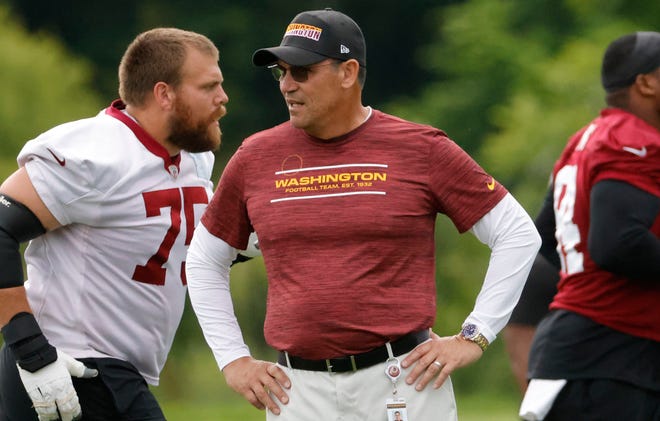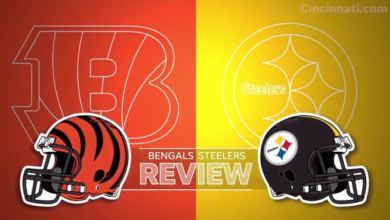
WASHINGTON — It took just a few seconds Saturday night for America’s Pastime to mix with one of America’s chronic ills.
And those chaotic few moments just before 9:30 p.m. in the nation’s capital, when baseball and gun violence found themselves intertwined, did far more than suspend the Washington Nationals-San Diego Padres game after a volley of gunfire outside Nationals Park wounded three, including a woman who attended the game.
It certainly revealed the very best in the fans who attended the game, the security staff that kept them calm as shots rang out but chaos was minimized, and the players and coaches of the Padres and Nationals, who welcomed strangers into the sanctum of their dugout and clubhouses in the name of safety.
Yet it also exposed, in a site supposed to be a sanctuary for athlete and fan alike, the numbing effect decades of mass shootings and gun violence have had on athletes and fans alike.

“As you all know, this is not just us,” Nationals manager Dave Martinez said Sunday morning, hours after helping fans to safety and even into his office. “It's happening everywhere.”
Based on police and eyewitness reports, Saturday’s shooting was not a premeditated act and probably not related to the ballgame. D.C. Metro Police said Sunday shots were fired from at least one vehicle into another – it’s possible an exchange of gunfire occurred – and they are seeking one car involved in the shooting after recovering another.
The shooting came one day after the District of Columbia was roiled by the killing of a 6-year-old girl, Nyiah Courtney, who was shot along with five adults in what police said was a drive-by shooting in Southeast D.C.
“Our city is heartbroken,” mayor Muriel Bowser said Saturday morning.
It was the 102nd homicide in the District this year, on the same pace as the same date in 2020, according to MPD data. The complex and deep-seated causes of those murders cannot be so easily summarized, although as displacement of residents in several quadrants of the city has risen, so, too, has the homicide rate.
Saturday night, that violence landed on the doorstep of Nationals Park, a publicly-funded jewel whose surrounding area has seen a boon in development – urban renewal to some, gentrification and displacement to others.
The scourge of violence does not often hit home to the Nationals or many of their fans who come to the District from the Maryland or Virginia suburbs. Martinez, who lives near the ballpark and has managed the Nationals since 2018, had to collect himself as he defended his adopted home.
“You know,” he said, pausing, “I love this city. This city is my home. It can get crazy. We all know that. And we all want to feel safe.
“I can tell you that inside this ballpark, I feel safer than ever. I really do.”
The actions of Martinez, the players and fans reflect generations that have grown up in a post-Columbine world.
'Just human beings'
In the minutes between the gunshots and the public-address announcement noting their origin and that sheltering in the stadium was safest, the instinctual reaction of fans and players rather concisely reflected a society in which mass shooting drills for kindergartners are standard.
Some fans sprinted for the center field exit. Others immediately ducked in their seats. Those in the sanctum of club seats and stadium restaurants even overturned tables to create safer havens.
For the players, many with family in the stands, it was a simple instinct: Reunite and protect.

“The shots happened in one second; you heard constant shooting,” Padres outfielder Wil Myers said Sunday. “From where we were, we didn’t hear any screams from any fans. It did take a little bit to realize it was gunshots.
“If we’d have heard screaming, we would’ve all known what was going on. At that point, you try to hear what people are saying and make your moves to get people safe in that instance.”
The Padres’ families were seated behind their third-base dugout and thus in decent proximity to the sound of the gunshots, which rang out near the third base entrance to the stadium. So Myers, whose parents attended the game after traveling from their North Carolina home, shortstop Fernando Tatis Jr. and third baseman Manny Machado went to the stands to help.
Family, fans, strangers – it didn’t matter.
“The situation changed immediately,” Tatis said Sunday. “There’s no longer player or fans. I feel like everybody is just people.
“Just human beings out there. Just need to be secure.”
All things considered – the announced crowd of 33,232, the chaos of gunfire, the initial confusion of its origin – the situation calmed in short order. Martinez credited MLB security official Brian Sedgwick with facilitating the transfer of fans from stands to dugout; he says there are protocols in place for such an incident, but those can quickly be lost in the haze of the event.
“You don’t even think it’s going to happen, but when it does, it’s definitely a different situation,” he says. “You got 30,000 fans. You got security workers. You got vendors. Tons of people that are out there that you worry about.
“Yesterday, everybody in this stadium, security, handled it really well. I thank the fans for doing the best they can to stay calm. They were all in our dugout like sardines, and I wanted to make sure they were safe and comfortable and they knew that we do care about that.
“That’s it. I just wanted everybody to be safe.”
'It could happen anywhere'
The fans would agree. They showed out strong for Sunday’s resumption of Saturday’s game and the regularly scheduled matinee, knowing security would be tighter – but still received some unsolicited advice.
“My wife said, be careful, be aware of your surroundings,” says D.C. resident David Adesnik, who brought his 6-year-old son to the game. “It’s something you might hear walking somewhere deserted late at night, not at a baseball stadium.”
Bethesda resident Kate Offutt spent part of the morning scrolling through Facebook and noting the surreal nature of Saturday’s events, which didn’t deter her or her friend from attending Sunday.
“If anything, I figured today would be safer than any day, though my husband gave some advice – to duck and cover,” says Liz, a Nationals fan from Bethesda who declined to give her last name. “If it’s a mass shooting, it could happen at the mall, at Wal-Mart, anywhere. It’s a matter of luck.”
She and Offutt both lived through the Beltway Sniper saga that paralyzed the capital region in 2002. That came three years after the school shooting at Colorado’s Columbine High School, a harbinger for two more decades of mass shootings. According to a Washington Post database that tracked 189 mass shootings since 1966, 43, or 25%, have occurred since 2016.
The deadliest shootings have tangentially touched baseball. The 2018 shooting at Marjory Stoneman Douglas High School in Florida prompted Chicago Cubs first baseman Anthony Rizzo to return to his alma mater for a vigil. Las Vegas-raised All-Stars Kris Bryant and Bryce Harper cut a public-service announcement during their 2017 playoff series, which happened to fall after a gunman perched in the Mandalay Bay resort murdered 59 people at a country music festival on the Strip.
Saturday’s shooting, though not nearly as tragic, was enough to disrupt the daily rhythms of a sport and pastime typically impervious to such tragedies. It was a sobering reminder that there are few shelters from the scourge.
“I hope that the fans come back and understand that, hey, this happens everywhere,” says Martinez. “Unfortunately, it’s scary when it happens. It's close to us.”









